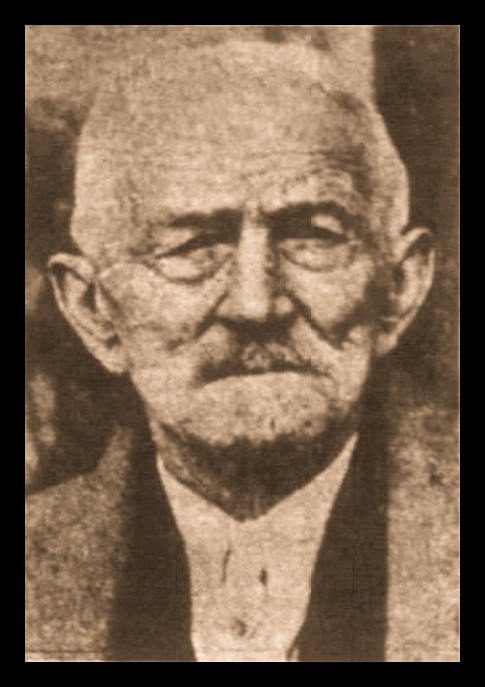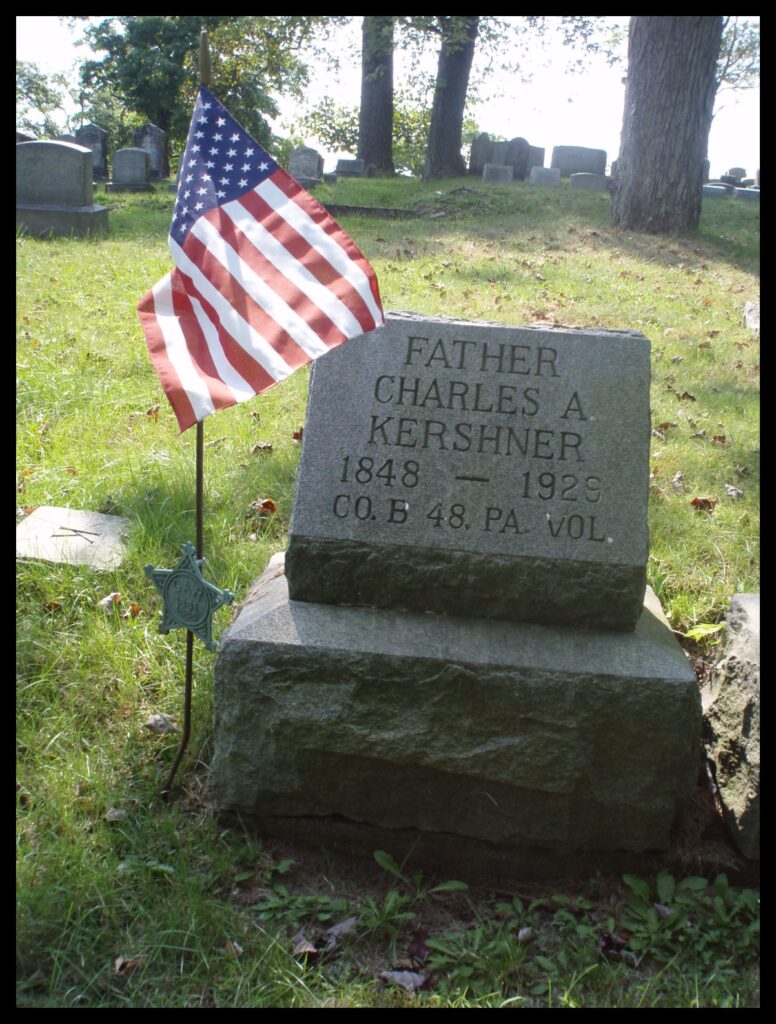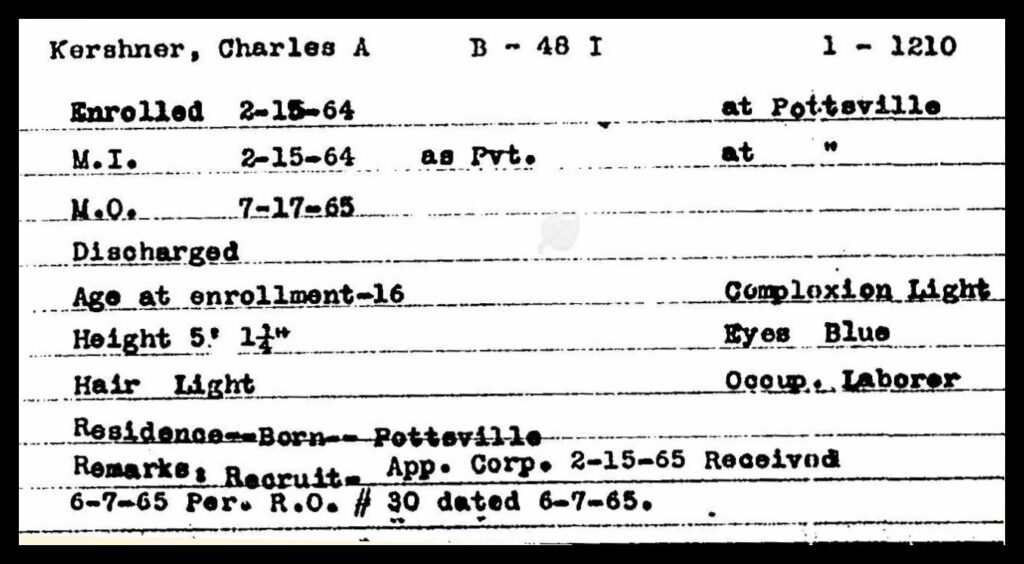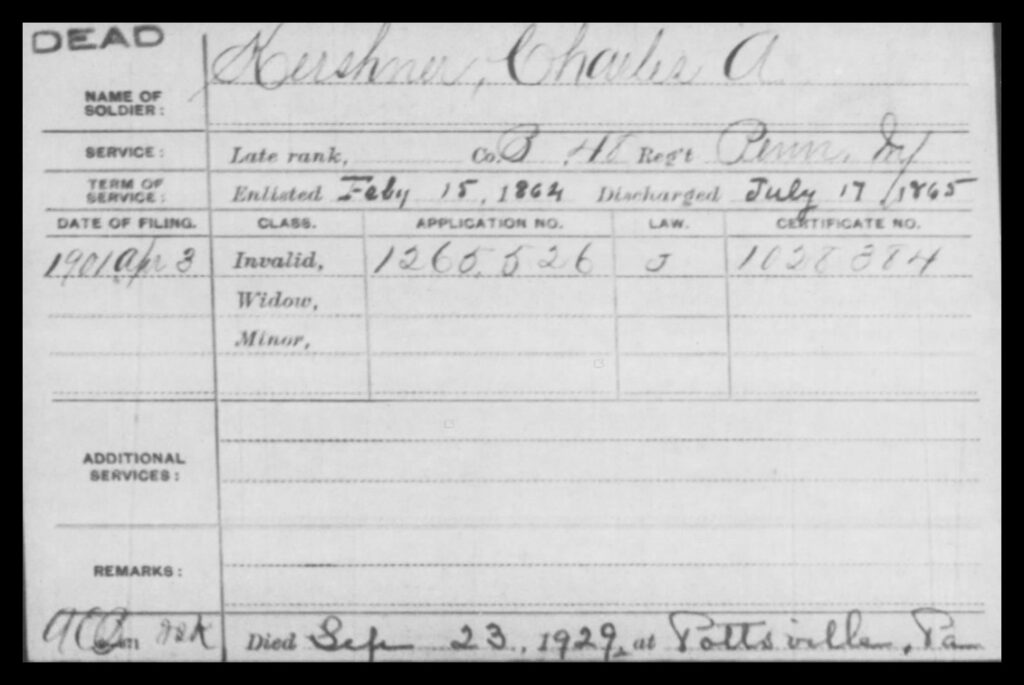In 1927, Charles A. Kerhner was interviewed by the Pottsville Republican for its “reminiscences” column. The interview was published on four successive days. Kershner told of life in Pottsville before and during the war, his military service during the Civil War and for more than thirteen years afterward, fighting the Indian Wars. In addition, he revealed that his wife traveled with him while he served out West. She received one ration per day as did he, and she made extra money by doing laundry. Following his war services, he returned to Pottsville, where he worked on the Reading Railroad, later as a private coach driver, and also as a boiler tender at the old Derr Foundry building.
Charles A. Kershner died September 23, 1929. He is buried in the Odd Fellows Cemetery in Pottsville.
The interview is transcribed in this blog post. Following the interview is his obituary and some documents related to his Civil War service.
________________________________________
From the Pottsville Republican, February 9, 1927, a story in part of a column titled “Reminiscences and Present Day Thoughts of Long Time Residents,” the author focused on Kershner’s war service, particularly with the 48th Pennsylvania Infantry.
When we celebrate the birthday anniversary of Abraham Lincoln, it is but fitting that we should give a moment’s thought and offer solemn tribute to those patriotic Pottsvillians who aided the great statesman in the preservation of the Union. Let us not forget that during the course of the great war Pottsville sent to the front one seventh of her population, or 13,000 young men and boys.
Some of the local men who served their country in these troublous times still live. Among them are: Albert Day, George F. Morgan, George Kupper, and Charles A. Kershner, all of the old 48th. There are others of various different regiments, who still survive, among them George Blank and Robert Reid….
Charles A. Kerschner is a fighter of much experience his activities not being confined to the Civil War; and he related many of those experiences to the writer… along with an account of some Pottsville changes of historical interest…. It is especially fitting that a Civil War veteran should be allowed to take the stand at this time, the occasion of the anniversary of the birthday of his chief, Abraham Lincoln.
____________________________________________
From the Pottsville Republican, February 10, 1927, a continuation of the reminiscences of Charles Kerschner:
Seated in the front room of his Centre Street home, Mr. Kerschner reminisced in a very interesting manner. He is a native of Pottsville, 79 years of age, and very well preserved. He is not active, in the sense of being employed, any more, having retired last fall; but his keen brain functions as well as ever, although he may at time feel his age in limb and body. I asked him to tell me something about his war experiences.
“Well,” he began, my Civil War service didn’t amount to much, to tell the truth. You see, I didn’t enlist until I was 16 years of age, and that was in ’64 when the war wad purt’ near over.” But, he added, “I did see some fighting at that. And after the fracas was over, I came back home, but found I was not satisfied outside the service. So I re-enlisted, and for more than 13 years I fought Indians in the West.”
There was a pause during which Mrs. Kerschner puffed contemplatively on his stogie, while I plied a few questions. Then he resumed.
“I had tried to get in the fray before ’64. Two attempts to run away from home were unsuccessful. In ’62 Mose Candee and myself tried to join the army which was then stationed at Aqua Creek. We got to Washington all right, but were stopped at Lone Bridge. Too many guards,” he chuckled, “so we had to come back; in fact, we were chased back. And the next year while the Battle of Gettysburg was being fought, I again ran away. This time I got as far as Ritesville, before I was stopped and returned to Pottsville. Then the following year, my father gave me his permission to enlist in the regular fashion, which I did.”
In reply to my comment that he was a mere boy when he became a warrior, he said, “They all were. That war was fought by boys, and especially near the end.”
I asked him how Pottsville had appeared during Civil War times. I wanted some information concerning recruiting, and other war activities.
“When I enlisted in ’64 recruiting was done in a shack which stood on the corner of Second and Norwegian Streets, where the post office now stands. That was the provost marshal’s office. There were two artilleries in town, one of them over on Norwegian Street near the present site of the Pennsy station, where the Washington Artillery, and the Scott Rifles used to drill, and other on Center Street, between Market and Arch, the meeting place of the National Light Artillery. All these companies enlisted in a body at the beginning of the war, and these places with the old barracks on Lawton Hill, were at some time or other during the war used to house the invalid soldiers.
“Pottsville had a real warlike atmosphere, for besides theses invalid barracks there was an encampment of the 21st Pennsylvania Cavalry out at Baber’s Cemetery, and at one time the 7th New Jersey camped at Tumbling run. I lived over on East Market Street at that time, and some of the boys who lived in my neighborhood were with me in the old 48th. There was Charlie DeLong who got homesick and died in Virginia (that homesickness was an awful thing); and John Stevenson, also dead now. Billy Stevenson gone too. Al Sands and Johnny Olewine. Johnny lay in a hospital beside me, when I was wounded in the foot. He had been hit in the head.”
The old warrior displayed the emotion he felt at the recollection of these old buddies by puffing furiously on his cigar.
____________________________________________
From the Pottsville Republican, February 11, 1927, a continuation of the reminiscences of Charles Kerschner:
Not wishing to break into his thoughts, which were sacred to the memory of pals now gone, I remained silent until I perceived that Mr. Kerschner had returned to the present. Then I asked him questions concerning his boyhood days in Pottsville and how the town looked in pre-war days.
“There were not so many stores in those days, and the town was rather sparsely populated except for Centre Street and thereabouts. Over on Norwegian Street, where Adam’s Express Office not stands, there was a screen factory, and across the creek which ran through there then there was a soap factory. Next to that, to the east, stood the Washington Artillery and Scot rifles Armory, then came Strouse’s shoe store, and next to that stood Masser’s carriage place. On the corner where now stands the hotel and cafeteria, there was a livery stable, kept by Nicholas Fox.
“Each store in those day was more specialized, selling only one line of merchandise. Meat, for instance was sold only in butcher shops, the same was true of other goods. Grocery stores handled only groceries although,” he added with a grin, “a person could also buy rum in them.
“At the corner of Centre and Norwwegian, near where Squire Davies now has his office, my father sold merchandise at a stand, somewhat like the one that is there now. I rememeber that on July Fourth he would stock up with fireworks – those were the days when the Fourth of July was a noisy day – and that seldom did that day pass without a fire at the old stand. Somebody would throw a lighted dynamite cracker of something into the works and there would be a beautiful display, followed by a fire. The fourth was a wild day.
“St. Patrick’s Day was another wild one; and on these two days there would be lights from one end of Centre Street to the other. Prohibition was unheard of, and drink entered into the celebration of those two days. Then there would be fights.” From his tome it could be inferred that he rather enjoyed watching, and perhaps participating in those celebrations.
“Out on North Centre Street, where the Safe Deposit Bank now stands, was the old Mortimer House, headquarters for the stage coaches which carried passengers and baggage between here and surrounding towns. Jake Huntzinger‘s Bank was also out there, and alongside it was an alley, separating it from a hotel kept by Jake Lindermuth, who also ran the exchange Hotel. In this alley there was a man shot, a deserter from the 70th New Jersey, which was stationed at Tumbling Run.”
Then the conversation reverted to the army, which is Mr. Kerschner’s favorite topic. He said that after the Civil War he found himself still craving action of a military nature, so he went over to the Silver Terrace Building, which was then the recruiting office, and which stood on the site now occupied by the Sheafer Estate Building, and there he was signed up by Col. Wister. He entered the Third Battalion, 12th U. S. INfantry, which became , after the reorganization which created a regiment of each battalion, the 30th U. S. Infantry. Two re-enlistments in this regiment, and then he joined the 5th U. S. Cavalry serving under Co. Merrit. He fought Indians in the West.
I asked him whether he liked to fight Indians.
“They were mean fighters,” replied, “especially after they learned to fight the white man’s way. Sioux and Apaches. They would throw up embankments of earth and lie behind them and shoot. Trenches. And when they got Winchesters, it was terrible. The Custer massacre was horrible. I didn’t see it, but I was in that territory when it happened.”
His tone implied that Indian fighters in that region were not exactly jubilant over the outcome of this affair.
__________________________________________________
From the Pottsville Republican, February 12, 1927, the conclusion of the reminiscences of Charles Kerschner:
Not being intimately acquainted with Mr. Kerschner, I asked him whether he had ever married.
“Oh yes,” he answered. “I married the eldest daughter of Louis Herwig, who used to keep a barber shop and toy store here in town. I married while still in the service and my wife traveled with me. Soldiers’ wives used to get one ration a day, same as the soldiers themselves did. And they earned extra money regularly by doing laundering jobs. I don’t know how they arrange those things nowadays.”
Then I inadvertently touched a tender spot of memory by inquiring further along these lines. His wife, I discovered, had passed away three years ago. Thus was a note of sadness brought into the interview which was dispelled when I suggested another topic, the Soldiers’ Monument in Garfield Square.
“I remember seeing him lay over at the station when he came in,” said the veteran. “He was erected by means of poles used to raise him into position. These poles were afterward spliced and became the Indian pole, which stood before the Hotel Allan for many years, and became a landmark in the town. This Indian stood at the corner of Centre and Mahantongo Streets, and was a competitive goal for the streams of the various fire companies. They would gather around him and try to shoot streams over his head. It was lots of fun. As well as my memory serves me the Good Intent Company was the only one to succeed in squirting a stream over him.
“The Indian still exists, although he has changed his abode. He stands on the hill over in Port Carbon, just as he used to stand at Centre and Mahantongo Streets, only somewhat changed in appearance because of exposure to all sorts of weather these many years.
After he left the service, Mr. Kerschner settled down in this city, working at various jobs here and there. For some years he was a railroader on the Philadelphia and Reading, working between this point and Sunbury. For many more years he was a private coachman, although he did mention the names of his employers. Then, as he grew older, gardening claimed his attention.
“At one time I worked in the old Derr Foundry,” he told me. “This was after is had passed from the hands of the original owners, and was being run by the York Safe Company. I fired the boilers there, as I did at many another place before and since. That is one of the local industries that have survived. Part of the old building still stands as it did when the Derr brothers conducted the business.”
By this time his cigar had become a heap of ashes, and with its passing all desire to talk seemed to have fled. And so I deemed it desirable to terminated the interview, making one last inquiry, which concerned his health.
“Oh, I’m in pretty good condition. Some days I feel real good, and other days not so good. Some time ago I had a fall and hurt my arm. This has bothered me off and on ever since. But I think for my age I’m doing well.”
To which I could not help but agree after having seen the results of the working of his mind, which retains all its old keenness.
_________________________________________________
From the Pottsville Republican, August 23, 1929:
CIVIL WAR VET ANSWERS CALL
After being in poor health for two months, and bedfast since Thursday, from complications due to advanced years, Charles A. Kershner aged 81, died at 7:30 O’clock, Monday morning at the home of his niece, Mrs. Ben Ellinger Jr., Minersville Street.
Mr. Kershner was adjutant of the Gowen Post No. 23, G. A. R. and his death now leaves but nine surviving Civil War Veterans in Pottsville. He is a member of the Methodist Church.
Mr. Kershner was a Civil War Veteran who followed the flag for years after the close of that conflict, to protect workmen constructing the Union Pacific and Central Pacific Railroad from Omaha to San Francisco, to fight the Sioux Indians under Red Cloud and Spotted Trail In Wyoming, to banish Roman Nose and his 9,000 Sioux across the Canadian border and to fight Apaches in Arizona.
He spent a total of 14 years in the service, beginning his career on February 15, 1864, with an enlistment in Company B of the 48th Pennsylvania Volunteers and ending it with a certificate of disability issued by a surgeon following Soldier Kershner’s fall into a ditch from horseback in 1878.
Comrade Kershner was with the 48th, then part of the Army of the Potomac, from the Wilderness Campaign to Appomattox. He was wounded at North Anna on May 24, 1864, and spent a month at Mt. Pleasant Hospital, Washington, D. D. Three months of civil life in Pottsville, the town of his birth on February 4, 1848, sufficed for Mr. Kershner again, he decided to become Solder Kershner again, and accordingly enlisted in the 13th U. S. Infantry at Pottsville on October, 13, 1866.
Until April of 1866, Soldier Kershner remained in Pottsville and later went to Philadelphia as a clerk in the recruiting service. Then he got a two weeks’ furlough and at the end of it joined Company A of the 13th Infantry at Washington, D. C. After re-arming with Spencer Carbines, a more effective weapon, the regiment went to Nebraska, where picks and shovels were busy on the new Union Pacific and Central Pacific Railroad.
On October 13, 1868, Soldier Kershner again became Mr. Kershner, to immediately re-enlist, this time in Company H, 30th U. S. Infantry. Sixty days furlough was the reward for reenlistment and at the end of that period Mr. Kershner joined his regiment at Fort Laramie, Wyoming, there to battle the aforesaid Sioux. Fort Fetterman where he received his discharge on Oct. 12, 1871, was the supply post for the regiment.
This time he reenlisted in the same company and regiment, again furlough for 60 days, rejoining this company at Fort C. F. Smith in Montana. There the Sioux under Turkey Foot and Big Mouth caused lots of trouble and later Roman Nose met death and defeat when his Sioux and Comanches across the border into the land of snows. Then the company went to Fort Wingate, New Mexico, for a rest; and while there Soldier Kershner, again became a civilian, through honorable discharge; and again he reenlisted this time in Company A of the 5th U. S. Calvary.
With this outfit, Warrior Kershner went to Arizona under Maj. General Crook, the man who took no prisoners. With him he fought Apaches in Arizona under Cheltapan, Deiche and Geronimo. The 6th U. S. Calvary relived the 5th and later went to Fort Hays, Kansas, for rest and recruits. While resting Comrade Kershner came to Pottsville on a 60 day furlough. He returned to Fort Hays and in the latter part of 1877 was throw from a horse which was in the act of jumping a ditch. Comrade Kershner’s kidneys suffered injury. and several months later he was discharged on the surgeon’s certificate of disability.
On June of 1863 , Elizabeth C. Herwig became the wife of Comrade Kershner. To them twelve children were born, three of whom are still living as follows: Harry Kershner, this city, Mrs. H. K. Johnson, Trenton, New Jersey, and Mrs. Lewis Davis, Philadelphia. There are also six grandchildren and seven great grandchildren. On February 21, 1923, Mrs. Kershner died.
He is also survived by two sisters, Laura Brown wife of Walter Brown of Detroit, Michigan, and Emma Smith the wife of William Smith, Pottsville.
____________________________________________________
CIVIL WAR RECORD
The Pennsylvania Veteran File Card (above) indicates that Charles A. Kershner was born in Pottsville and was 16 years old at the time he enlisted as a recruit at Pottsville in the 48th Pennsylvania Infantry, Company B, February 15, 1864. He stood 5 feet, 1.25 inches tall, had light hair, a light complexion, and blue eyes. He indicated he was a laborer. Charles A. Kershner was mustered into service as a Private on the same day as his enlistment.
The Bates reference for Kershner’s name on the muster rolls of the 48th Pennsylvania Infantry is in the upper right corner of the card: 1 – 1210 (Volume 1, page 1210). Bates notes at the top of the roll for Company B that this group of soldiers was primarily from Schuylkill County.
To follow the military service of Kershner, go to Bates, Volume 1, page 1196, where the story of the 48th is told from the time of his enlistment. Use the “next” tab on the page to continue reading. The actions in which Kershner’s company were involved included the Siege of Petersburg, the digging of the mine tunnel, and the explosion creating the crater.
The card also shows that he applied for the rank of Corporal on February 15, 1865, and received that rank on June 7, 1965. His honorable discharge came on July 17, 1865 at the rank of Corporal, although Bates does not indicate that.
The Pension Index Card (above), available from Fold3, shows that Charles A. Kershner applied for an Invalid Pension on April 3, 1901, based on his service in the 48th Pennsylvania Infantry, Company B. The dates of his term of service conform with the information on the Pennsylvania Veteran File Card. A Certificate Number indicates that he was awarded the pension, and the death date/place at the bottom of the card, September 23, 1929, at Pottsville, is an indication that he collected until his death. No widow applied. It has been previously noted that Kershner’s wife died before him and when he was interviewed for the Pottsville Republican, he was widower.
_______________________________________________
News articles are from Newspapers.com. Portrait of Charles A. Kershner was published at the time of his death in the Pottsville Republican. Pennsylvania Veteran File Card is from the Pennsylvania Archives and is now available on Ancestry.com. Pension Index Card is from Fold3.
A prior post on this blog featured the arrest and conviction of Charles A. Kershner for assaulting five young girls and his imprisonment for nine months. That post also told of his paid testimonials for Doan’s Kidney Pills.
Corrections and additional information should be added as comments to this post.



